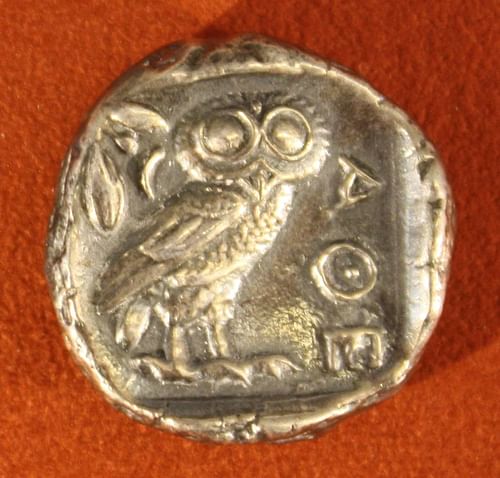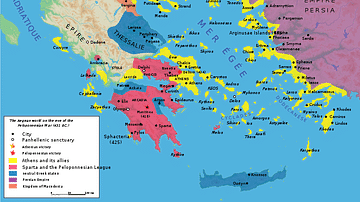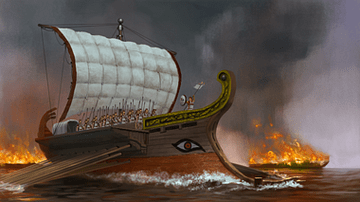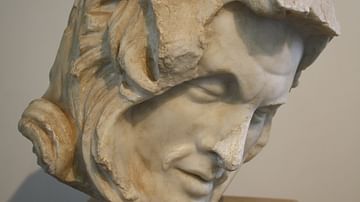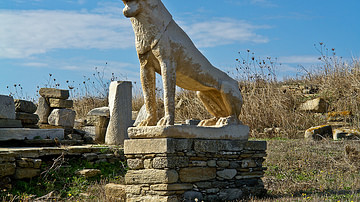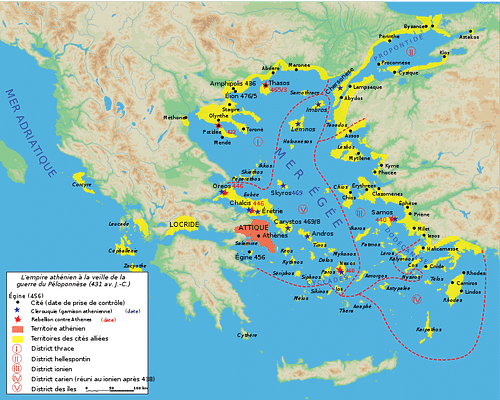
The Delian League (or Athenian League) was an alliance of Greek city-states led by Athens. The league was formed in 478 BCE to liberate eastern Greek cities from Persian rule. The league was then used as a defence against possible revenge attacks from Persia following the Greek victories at Marathon, Salamis, and Plataea in the early 5th century BCE.
The alliance of over 300 cities within the League would eventually be so dominated by Athens that, in effect, it evolved into the Athenian empire. Athens became increasingly more aggressive in its control of the alliance and, on occasion, constrained membership by military force and compelled continued tribute which was in the form of money, ships or materials. Following Athens' defeat at the hands of Sparta in the Peloponnesian War in 404 BCE the League was dissolved.
Membership & Tribute
The name Delian League is a modern one, the ancient sources refer to it as simply 'the alliance' (symmachia) or 'Athens and its allies'. The name is appropriate because the treasury of the alliance was located on the sacred island of Delos in the Cyclades. The number of members of the League changed over time but around 330 are recorded in tribute lists; sources which are known to be incomplete. The majority of states were from Ionia and the islands but most parts of Greece were represented and later there were even some non-Greek members such as the Carian city-states. Prominent members included:
and many other cities across the Aegean, in Ionia, the Hellespont, and Propontis.
Initially members swore to hold the same enemies and allies by taking an oath. It is likely that each city-state had an equal vote in meetings held on Delos. Members were expected to give tribute (phoros) to the treasury which was used to build and maintain the naval fleet led by Athens. Significantly too, the treasury was controlled by Athenian treasurers, the ten Hellenotamiae. The tribute in the early stages was 460 talents (raised in 425 BCE to 1,500), a figure decided by Athenian statesman and general Aristides. An alternative to providing money was to give ships and/or materials (especially timber) and grain.
What Were the Delian League's Successes & Failures?
The Delian League enjoyed some notable military victories such as at Eion, the Thracian Chersonese, and most famously, at the Battle of Eurymedon in 466 BCE, all against Persian forces. As a consequence Persian garrisons were removed from Thrace and Chersonesus. In 450 BCE the League seemed to have achieved its aim if the Peace of Kallias is to be considered genuine. Here the Persians were limited in their field of influence and direct hostilities ended between Greece and Persia.
Other successes of the League were not military but economic and political, making them more difficult to determine in their significance and real effect for all members. Piracy was practically eliminated in the Aegean, inter-city trade increased, a common coinage was introduced (the Athenian silver tetradrachm), taxation became centralised, democracy as a form of government was promoted, the judiciary of Athens was accessible to member's citizens, and such tools as measurement standards became uniform across the Aegean. The primary beneficiary of all of these was certainly Athens and the massive re-building project of the city, begun by Pericles and which included the Parthenon, was partially funded by the League treasury.
The League and its requirement of tribute was not always to the liking of its members and some did try and leave, especially as the threat from Persia gradually receded and the calls for tribute increased. A notable example is Naxos who sought to secede c. 467 BCE. Athens responded in dramatic fashion by attacking the island and making it a semi-dependency, albeit with a lower tribute. Thasos was another member who disagreed with Athens and wanted to keep control of its mines and trade centres. Again, the Athenians responded with force in 465 BCE and lay siege to the city for three years. Eventually, Thasos capitulated.
From Alliance to Empire to Collapse
Already looking like an Athenian empire, two further episodes changed the League forever. In 460 BCE the First Peloponnesian War broke out between Athens, Corinth, Sparta, and their allies. For the first time the League was being used against Greek city-states and Persia was off the agenda. Then c. 454 BCE Athens used the excuse of a failed League expedition in Egypt (to aid the anti-Persian prince Inarus) to move the League treasury to Athens.
The League became, thenceforth, ever more difficult to keep in toe. In 446 BCE Athens lost the Battle of Koroneia and had to repress a major revolt in Euboea. An even more serious episode occurred when fighting between Samos and Miletos (both League members) was escalated by Athens into a war. Again the Athenians' superior resources brought them victory in 439 BCE. Yet another revolt broke out in Poteidaia in 432 BCE which brought Athens and the Delian League in direct opposition to Sparta's own alliance, the Peloponnesian League. This second and much more damaging Peloponnesian War (432-404 BCE) against a Persian-backed Sparta would eventually, after 30 years of gruelling and resource-draining conflicts, bring Athens to her knees and ring the death knell for the Delian League. Such disastrous defeats as the 415 BCE Sicilian Expedition and the brutal execution of all males on rebellious Melos the previous year were indicators of the desperate times. Athens' glory days were gone and with them, so too, the Delian League.
Conclusion
The benefits of the League had been, certainly, mostly for the Athenians, nevertheless, it is significant that the realistic alternative – Spartan rule – would not have been and, from 404 BCE, was not any more popular for the lesser states of Greece. This is perhaps indicated by their willingness to re-join with, albeit a weaker and more militarily passive, Athens in the Second Athenian Confederacy from 377 BCE.
Learn more about the Delian League in this series of articles:
- The Delian League, Part 1: Origins Down to the Battle of Eurymedon (480/79-465/4 BCE)
- The Delian League, Part 2: From Eurymedon to the Thirty Years Peace (465/4-445/4 BCE)
- The Delian League, Part 3: From the Thirty Years Peace to the Start of the Ten Years War (445/4–431/0 BCE)
- The Delian League, Part 4: The Ten Years War (431/0-421/0 BCE)
- The Delian League, Part 5: The Peace of Nicias, Quadruple Alliance, and Sicilian Expedition (421/0-413/2 BCE)
- The Delian League, Part 6: The Decelean War and the Fall of Athens (413/2-404/3 BCE)
